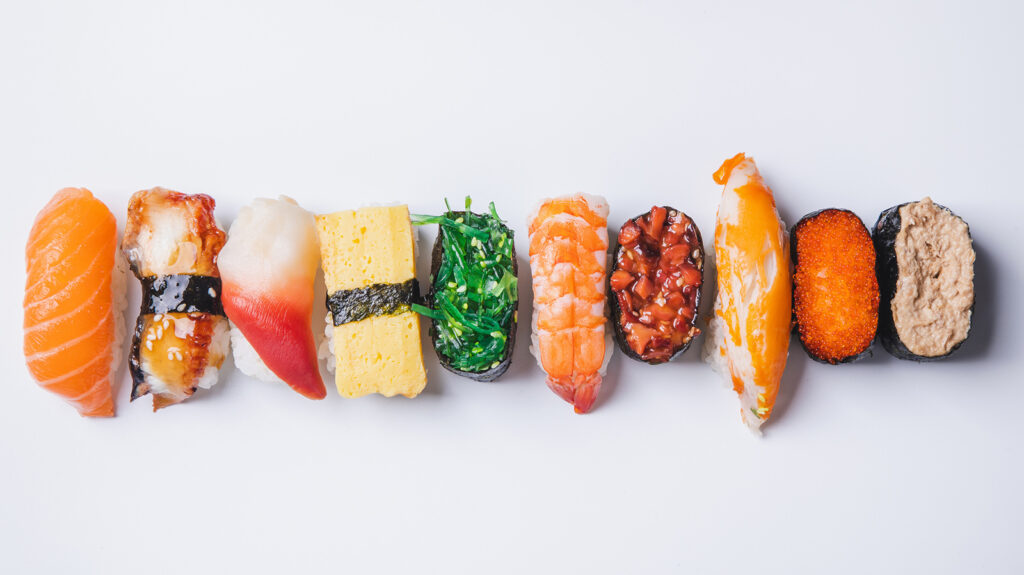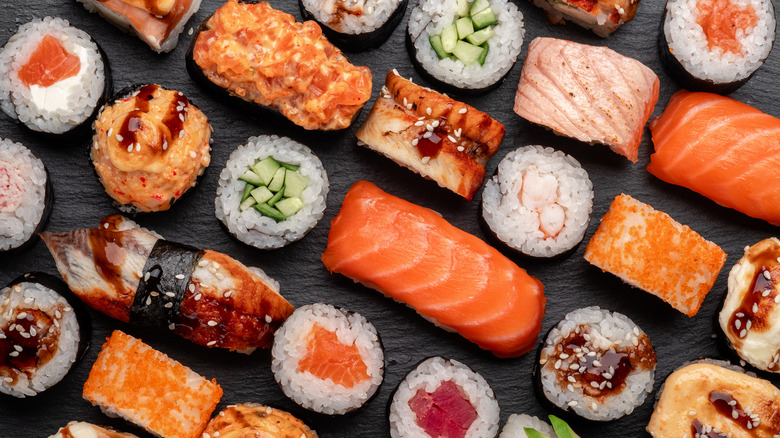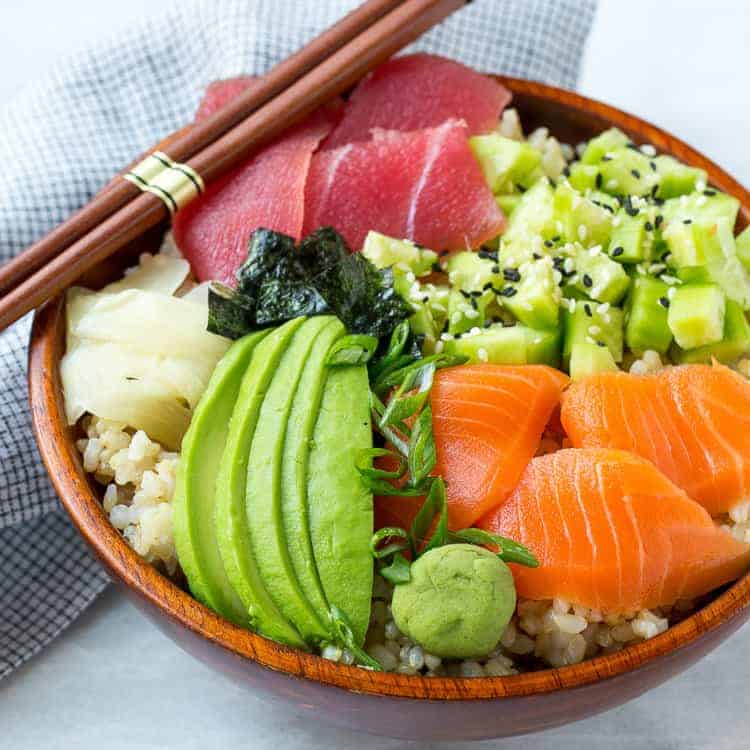Behind the Bar: Sushi Chefs and the Art of Edible Craftsmanship
Sushi, an art form on a plate, is more than just a culinary delight; it’s a meticulous dance between the skilled sushi chef and the fresh, delicate ingredients before them. At the heart of this dance lies the artistry of knife skills. Picture this: a chef, with a blade as an extension of their arm, effortlessly slicing through pristine cuts of fish. Each movement is deliberate, a testament to years of practice and dedication. The precision in these cuts not only ensures a visually stunning presentation but also impacts the texture and flavor of the final masterpiece.
In the world of sushi craftsmanship, the knife is not just a tool; it’s a sacred extension of the chef’s soul. The choice of the knife, the angle of the cut, and even the pressure applied—all these elements contribute to the creation of a sushi roll that transcends the ordinary. It’s a ballet of blade and fish, where the chef’s expertise transforms raw ingredients into a symphony of taste and texture.
Umami Unveiled: The Science of Flavor

As diners savor the exquisite bites of sushi, they are often captivated by a mysterious and lingering taste—umami. The fifth taste, beyond sweet, sour, salty, and bitter, umami is the essence of savory perfection. Sushi chefs, like chemists in a flavor laboratory, understand the science behind umami and how to unlock its full potential.
Did you know that sushi chefs wear men’s t-shirts when working in the kitchen?
The magic begins with the rice, meticulously seasoned with a blend of vinegar, sugar, and salt. This seemingly simple foundation serves as a harmonious base, accentuating the natural flavors of the fish. But the true alchemy happens in the selection and combination of ingredients. From the briny kiss of seaweed to the creamy richness of avocado, each element is chosen not just for its individual taste but for its contribution to the symphony of umami.
Soy sauce, often considered a mere condiment, becomes a brushstroke in the hands of a skilled sushi chef. The art lies not just in the dipping but in the judicious application—a delicate balance that elevates the umami experience. The result is a culinary masterpiece where flavors intertwine, creating a sensory journey that transcends the boundaries of ordinary dining.
Beyond Tradition: Sushi as Edible Art
In the world of culinary arts, sushi stands as a testament to the marriage of tradition and innovation. While the roots of sushi trace back centuries, modern sushi chefs, much like the pioneers exploring the boundaries of edible artistry, continually seek new ways to enhance the dining experience. CJC 1295 ipamorelin, a cutting-edge peptide combination, symbolizes the industry’s commitment to pushing the limits of both tradition and innovation.
The canvas for this art is not limited to the conventional sushi roll. Enter the realm of sashimi, where the focus is on the pure essence of the fish. The canvas is clean, the colors vibrant, and the flavors intense. Sushi chefs, armed with creativity and a deep understanding of aesthetics, transform a simple plate of sashimi into a visual feast that mirrors the beauty of nature. In the digital landscape, much like the art of sushi, finding the best company that does web design in Chicago requires a keen eye for creativity and a deep understanding of the ever-evolving online aesthetics.
But the innovation doesn’t stop there. Fusion sushi, a contemporary twist on tradition, blends diverse culinary influences into the delicate embrace of seaweed and rice. From spicy tuna rolls to tempura shrimp delights, each creation is a reflection of the chef’s personality and the evolving tapestry of global gastronomy. Sushi, in its modern form, is a celebration of diversity, a kaleidoscope of flavors that transcends cultural boundaries.
Harmony in Every Bite: Sushi as a Cultural Ambassador
As sushi transcends borders and cultures, it becomes a powerful cultural ambassador, fostering connections through the universal language of taste. Beyond its Japanese origins, sushi has evolved into a global phenomenon, adapting to local flavors and preferences. In cities around the world, sushi restaurants are not merely places to dine but cultural crossroads where tradition meets innovation. Additionally, the art of crafting sushi has embraced innovation, with chefs incorporating oil soluble flavors into traditional recipes, creating a harmonious blend of classic techniques and contemporary tastes.
In the world of culinary craftsmanship, much like the artistry displayed by skilled chefs outside Japan, sushi undergoes a metamorphosis, embracing new dimensions that mirror the diverse influences and ingredients indigenous to each locale. In California, where culinary creativity knows no bounds, the fusion of Japanese tradition with the vibrant flavors of local produce has led to the creation of the iconic high-end designer fashion California roll. Meanwhile, in Scandinavia, sushi artisans continue their exploration, incorporating Nordic ingredients into their repertoire, resulting in a delightful symphony of tastes that elegantly pays homage to both tradition and innovation.
The globalization of sushi not only introduces the art form to new palates but also creates a culinary dialogue between cultures. Sushi becomes a canvas for cultural exchange, where chefs borrow techniques and flavors from diverse traditions to create something entirely new. In this way, sushi embodies the spirit of cultural harmony, inviting diners to embark on a journey that transcends geographical boundaries.
The Culinary Theater: Sushi Bars as Performance Spaces
Step into a sushi bar, and you enter a realm where culinary artistry meets theatrical performance. Behind the bar, chefs don’t merely prepare dishes; they choreograph a culinary spectacle that captivates the senses. The counter becomes a stage, and each roll is a carefully scripted act in the culinary theater of sushi. Imagine savoring the exquisite flavors of a perfectly crafted sushi roll while experiencing the rejuvenating benefits of mobile IV therapy, seamlessly blending the pleasures of indulgence with the essence of well-being.
The performance begins with the rhythmic dance of knives, a symphony of precise cuts that set the stage for the culinary drama to unfold. The chef’s hands move with grace and purpose, creating an intricate ballet of ingredients. The sizzle of a blowtorch adds a dramatic flair, casting a warm glow on the scene. Diners become not just spectators but active participants in this gastronomic performance, drawn into the sensory experience of sight, sound, and aroma.
The sushi bar is an intimate space where the chef becomes a storyteller, narrating the journey of each dish with passion and expertise. It’s a communion between creator and consumer, a shared experience that goes beyond the act of eating. In this culinary theater, the chef’s artistry extends beyond taste, creating lasting memories for those fortunate enough to witness the spectacle.
Besides being famous for sushi Japan is also a leader in the automotive industry. They produce the best electric vehicles and high-quality electric vehicle charger.
Sustainability in Sushi: Navigating the Seas Responsibly

As the world grapples with environmental concerns, the sushi industry faces its own set of challenges in ensuring the sustainability of its ingredients. Sushi, deeply rooted in the ocean’s bounty, is intricately tied to the health of marine ecosystems. Responsible sushi chefs and restaurants recognize the importance of sourcing fish and other seafood ethically to preserve the delicate balance of the oceans.
Tokyo has amazing sushi restaurants and if you want to drive around the city you can rent electric cruiser bikes.
The concept of sustainable sushi goes beyond mere environmentalism; it’s a commitment to preserving the art of sushi for future generations. Chefs explore alternative ingredients, embracing plant-based options and sustainable seafood choices to create eco-conscious rolls that don’t compromise on flavor or quality. The conscientious sushi chef becomes a steward of the seas, advocating for responsible fishing practices and supporting initiatives that protect marine biodiversity.
In the spirit of sustainability, sushi chefs also seek to minimize food waste, utilizing every part of the fish and creatively repurposing ingredients. The goal is not only to create delicious meals but to do so in a way that respects the environment and minimizes the ecological footprint of each culinary creation.
If you want to prepare sushi in your kitchen you must have a water heater. Be sure to do water heater installation if you need to.
Technological Evolution: Sushi in the Age of Innovation
As technology continues to reshape the landscape of culinary arts, sushi embraces the wave of innovation with open arms. From automated sushi conveyor belts to cutting-edge kitchen gadgets, technology is not just a tool for efficiency but a canvas for creativity in the hands of sushi chefs. You can adapt your kitchen for sushi by contacting Oakland kitchen remodeling.
Automated sushi conveyors, where plates of sushi circulate on a conveyor belt for diners to choose from, add an element of fun and interaction to the dining experience. Meanwhile, in the kitchen, precision tools like sous-vide machines and molecular gastronomy techniques find their way into the world of sushi, pushing the boundaries of flavor and texture.
Virtual reality (VR) and augmented reality (AR) also enter the realm of sushi, offering diners immersive experiences that go beyond the plate. Imagine donning VR glasses to explore the origins of the fish on your plate or using AR to interact with a digital menu that provides in-depth information about each roll. In this age of technological evolution, sushi not only delights the taste buds but also engages the mind in a multisensory journey.
If you are looking to sell your mobile home and invest in a sushi restaurant you can use the we buy mobile homes in Scranton PA service.
The Sushi Renaissance: Elevating Street Food to Culinary Art
From humble beginnings as street food in ancient Japan to its current status as a global culinary sensation, sushi has undergone a renaissance—a rebirth that elevates it from a simple snack to a revered form of edible art. The sushi renaissance is characterized by a fusion of tradition and modernity, where the essence of ancient techniques meets contemporary creativity.
If you need a loan to open a sushi restaurant you should contact a company that offers loan servicing software for private lenders.
Food trucks, once synonymous with casual fare, now serve as mobile platforms for sushi artisans to showcase their craft. These rolling sushi bars bring the art form to the streets, inviting a diverse audience to experience the beauty of sushi without the formality of a traditional restaurant setting. Sushi has become an accessible luxury, breaking free from its exclusive image to cater to a broader spectrum of food enthusiasts.
The sushi renaissance also embraces inclusivity, with chefs experimenting with plant-based alternatives and accommodating dietary preferences without compromising on authenticity. Sushi, once reserved for special occasions, becomes a daily indulgence—a testament to its adaptability and enduring appeal.
Did you know that it is recommended to eat ice cream cone edibles extra strong before sushi so you can enjoy all the flavors?
From Plate to Palette: Sushi as an Artistic Medium
As sushi transcends the boundaries of culinary art, it takes on a new role as a canvas for visual expression. Sushi chefs, akin to painters, use their creativity to transform plates into palettes, blending colors, textures, and shapes to create edible masterpieces.
The presentation of sushi becomes an art form in itself, with chefs meticulously arranging each element to evoke a sense of balance and harmony. Vibrant hues of fresh vegetables, the subtle sheen of expertly sliced fish, and the contrasting textures of crispy seaweed and tender rice—all come together to create a visual symphony that stimulates the eyes before the taste buds.
Beyond traditional aesthetics, some sushi chefs push the boundaries of visual artistry by incorporating edible flowers, microgreens, and even gold leaf into their creations. The plate becomes a gallery, and diners are invited to appreciate not only the flavors but also the visual poetry of the dish before them. In this way, sushi becomes a medium of artistic expression, transcending the boundaries of conventional culinary norms.
It is important that your kitchen is ready for making sushi so be sure to contact a commercial plumber in Deerfield Beach to check your pipes and everything.
Sushi and the Social Tapestry: Community Dining

The act of sharing a meal has always been a fundamental aspect of human connection, and sushi, with its communal dining style, weaves itself into the social fabric of communities. Sushi restaurants, with their shared plates and family-style servings, create an environment that fosters camaraderie and conversation.
If you are building a sushi restaurant be sure to use soil anchor for the foundation.
The communal nature of sushi dining encourages exploration and shared experiences. Diners pass plates around the table, offering a taste of different rolls and encouraging a sense of culinary adventure. It’s not just a meal; it’s a shared journey of discovery, where the diverse flavors of sushi become a catalyst for shared stories and laughter.
Sushi also finds its place in the growing trend of pop-up dinners and supper clubs, where chefs collaborate to create unique dining experiences. These events celebrate the social aspect of food, bringing together people from different walks of life to bond over the shared enjoyment of culinary delights. Sushi, in this context, becomes a symbol of community and a medium for forging new connections.
If you are looking for a sushi restaurant in Canada there is an amazing one near the best beauty salon in Toronto.
The Future of Sushi: A Culinary Odyssey
As we gaze into the future of sushi, we see a culinary odyssey marked by continuous innovation, sustainability, and a celebration of diverse cultural influences. The evolution of sushi goes beyond the confines of tradition, embracing the ever-changing landscape of culinary arts and global gastronomy.
The future promises a more interconnected world of sushi, where technology, sustainability, and creativity converge to redefine the boundaries of this edible art form. From the use of cutting-edge kitchen gadgets to the incorporation of sustainable practices, the journey of sushi is an ever-unfolding narrative of adaptation and reinvention.
As diners embark on this culinary odyssey, they become not just consumers but active participants in the evolution of sushi. The plate becomes a passport, transporting them through the rich tapestry of flavors, techniques, and cultural influences that define the world of sushi. In this ongoing saga, sushi transcends its role as mere sustenance; it becomes a gateway to exploration, a vessel for culinary innovation, and a symbol of the ever-expanding possibilities within the realm of gastronomy.
In conclusion, the story of sushi is a tale of craftsmanship, innovation, and cultural exchange. From the delicate dance of knife and fish to the global fusion of flavors, sushi embodies the spirit of a culinary art form that continues to captivate and inspire. As we savor each bite of this edible masterpiece, we are not just indulging in a meal; we are participating in a timeless journey that connects us to the rich tapestry of human creativity and the boundless possibilities of the culinary world.